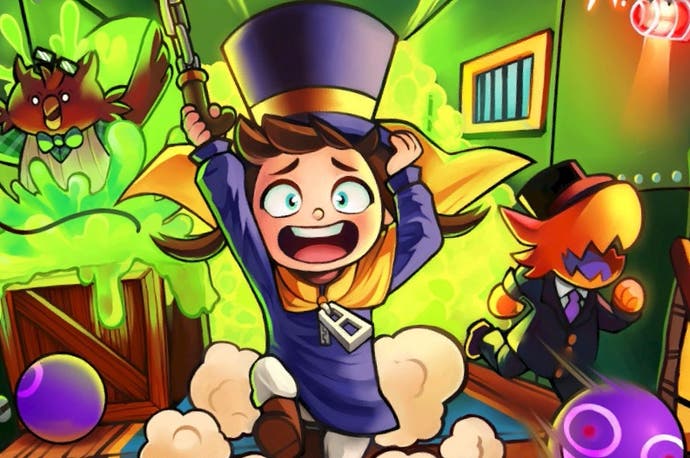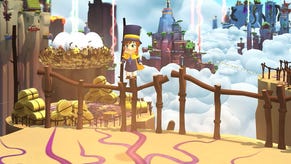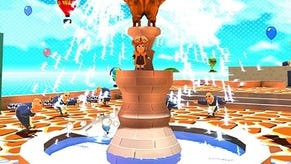A Hat in Time review
Who wants to be a milliner?
You fight a toilet in A Hat in Time. It's a boss fight, too; it's actually quite tough to put that toilet down for good. It's a spooky toilet you're fighting, of course, so you have to factor in ghosts and green-glowing wraiths that swoop and lunge. It's an acrobatic toilet too, so you need to watch out when it's starting to feel spry and stompy.
In other words, A Hat in Time is marvellous. It is so much fun. This is a 3D platformer Kickstarted off the back of the fact that a bunch of people out there really like 3D platformers and are sad that they don't make many of them anymore. This places it alongside the likes of Yooka Laylee, I guess, but A Hat in Time actually feels very different. Mostly, I think, this is down to the game's dual narrative, one strand of which must be inferred. I might be totally wrong about this second narrative, but the game seems to make a convincing case for its existence.
A traveller through the stars, decked out with a magical hat, who spills a precious cargo of magical hourglasses over a strange planet and must then reclaim them all: this is the organising plot of A Hat in Time, your stated reason for all that jumping and running and bouncing off the heads of baddies. But it is not the only story the game is telling, and it is not the most engrossing. As you move from the elbowy, fidgety, any-idea-is-worth-trying confines of Mafia Town, the game's first area, through haunted woods and rival movie studios to the high-altitude roominess of Alpine Skyline, where bird cages and lava cakes hang in the chilly heavens, it's hard not to be drawn along by a glorious sense of progression, of escalation. You're picking up new skills and confronting new challenges, sure, and you're collecting all those hourglasses. But there's more to it than that. A Hat in Time's real story, I suspect, is of an imaginative team that loves platformers steadily learning how to make a really great one.
It's still fun back at the very start, granted. Mafia Town may be a bit cluttered, its roving enemies may be rather sparsely animated, and its overall theme - the enduring whimsy of organised crime - might feel a touch too much like a private joke, but it's fun to navigate this busy island, taking on the odd boss, discovering nooks and crannies where collectables lurk, and fumbling your way through early attempts to make platforming levels that tell simple narratives. If you've played Super Mario 64 or any of its lineage you'll be entirely comfortable with the basic format: A Hat in Time drops you into brightly coloured worlds that are generally built to allow room for a handful of different levels to play out, each one concluding with the collection of an hourglass. One moment you're chasing someone through the rain and trying to scare them, the next minute the whole place has been filled with lava and you're bouncing between huge taps trying to cool everything down. Once you've collected enough hourglasses, you're off somewhere else - a new landscape with the potential for a new bunch of levels.
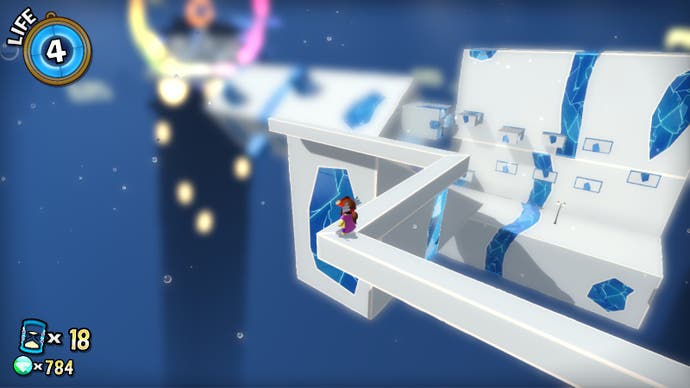
At times, you'll be comfortable with more than the basic structure, to be honest. While the beautiful weight and handling of a classic Mario is beyond A Hat in Time - that sense of being a part of the landscape when your feet touch the ground, and of feeling the game's gravity holding you as you spring elastically into the air - much of the more obvious detailing has been carried over. From individual gimmicks, such as a level in which saw blades cut the ground out from under you, to UI elements such as a familiar segmented health dial, and even down to the way the camera swoops around a new location or zooms in on a part of the hub world that you have just unlocked, this is a game that carries its inspirations fairly openly.
It has its own ideas, though. There are the hats that your hero wears for starters, new ones available if enough wool is collected by scouring levels. Each hat grants its own power. The standard hat allows you to pinpoint your objective - with mixed success, to be honest. Another might allow you to race along a bit faster in bursts, or conjure fireballs that destroy specific parts of the scenery. Hats are soon joined by badges that grant additional skills. There's a badge that allows you to swing from hooks in the sky, and another that reveals the location of nearby collectables. It's a slightly messy system - hats and badges kind of doing the same sorts of things - but it offers a nice sense of progression and it encourages you to return to old levels with new gadgets.
The game's really good ideas often come down to the levels themselves, however. If Mafia Town seems pleasant but slightly ropy and shapeless in its construction, the game quickly grows more ambitious - and more focussed. Trips to a Movie-themed area introduce familiar elements like stealth, but also unfamiliar elements like a conga-line that follows you through certain levels and will kill you if it bumps into you. Episodic narrative intrudes more clearly as you progress: one minute you're making a film, the next minute you're exploring a sepia-tinged steam train, unlocking a maze of carriages and collecting dossiers as you try to solve an Agatha Christie-style murder. In the haunted woods, a demon of some sort is roping you into signing deadly contracts. In one level you're sneaking around a spooky house avoiding detection, and after the next roll of the dice you're burning cursed paintings and fighting that surprisingly limber toilet. Execution varies - and in narrow spaces the camera struggles occasionally - but the sheer energy and evident joy of creation pushes you forward.
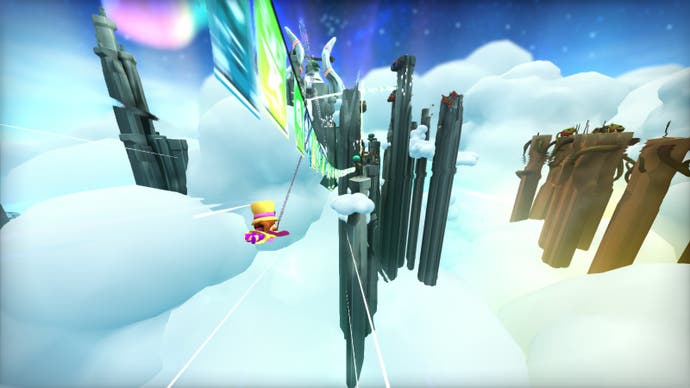
For me it all comes together in the alps, a series of distant mountain peaks, each one vertiginous and tricksy, each one with its own gimmicks and secrets and treasures. After hours of moving between strange episodes, I was suddenly in free-range mode. I spent a fantastic afternoon in this huge, colourful space, working out where I wanted to get to, muddling through the process of getting there, grinding the most out of my move-set - a double-jump, an air-dash, a sort of targeted bottom-bounce and the ability to whack people with a brolly - and taking in the sights. Mafia Town, entertaining as it is, feels like a very distant memory up here.
I have no idea if this is how games like A Hat in Time get made - in stages, with later levels sometimes learning the lessons of the earlier levels. I am probably very wrong. But there is a palpable sense of discovery to the game, nonetheless, a sense of a design team unlocking the confidence to try the kinds of things the game increasingly tries to do. Whatever's really at work, A Hat in Time starts as a warm curio, and by its conclusion it is hitting some surprisingly high notes.
